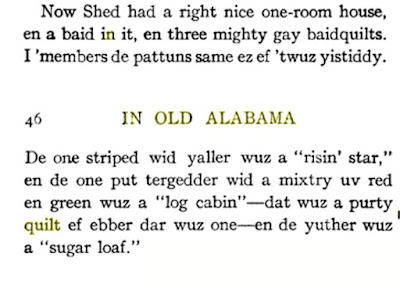There's more to intrigue the skeptical historian in the tale. Sarah Kemble Knight (1665 or 1666-1727) was quite the historical figure for those interested in Colonial history in the 19th and early 20th centuries. But what is the evidence for the quilt fragment's association with this important woman?
Apparently a note dated in 1727 came with the quilt, now kept with the Alabama fragment at Magnolia Grove. Sarah Kemble Knight was the note's reputed author who wrote she'd made the quilt 45 years earlier.Magnolia Grove today. Greensboro is in Hale County in west central Alabama
Then the New England chain is broken and the next recorded owner (with a gap of 52 years between their lives) is Sarah Anne Pearson Croom, born in North Carolina, Her father, a Virginia native, was Rowan County's largest slave holder. Sarah's husband Isaac Croom, also a North Carolinian, built Magnolia Grove in 1840 where the quilt fragment resides today. The Greensboro, Alabama house was the Croom's town home. They were cotton planters with rural farms extending into nearby counties. The 1860 census valued his Marengo County assets at $246,810 (slaves included). The Crooms had no children.
https://www.findagrave.com/memorial/72246418/sarah-anne-croom
Sarah Croom's niece, Sarah Pearson Hobson from North Carolina, bought the house in the 1870s after the Crooms died and raised her six children there.
This Sarah called Anne was an Alabamian, born and died at Magnolia Grove, single all her life. She published a 1903 book of folk stories told in the ever-popular dialect form of the era. In Old Alabama, Being the Chronicles of Miss Mouse, the Little Black Merchant she mentions quilts in the context of a tale about her Black neighbors, noting patterns Rising Star, Log Cabin and Sugar Loaf.
In 1938 Vera Henry, collecting local
stories for a W.P.A. project, wrote about Magnolia Grove, noting two Hobson
sons and two daughters lived there: Perhaps Samuel who was about 60; Joseph 58,
Sarah Anne 54 and Margaret 55, all of whom never married.
https://www.loc.gov/resource/wpalh0.07013203/?st=gallery
It seems many of the Croom/Hobson family were keepers of family traditions, including the quilt apparently promised to Sarahs over the years.
Next Post: A break in the chain of Sarahs.










Can't wait for post #3!
ReplyDelete